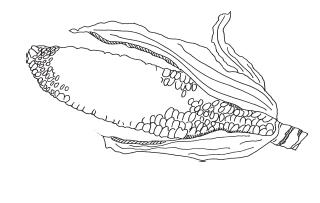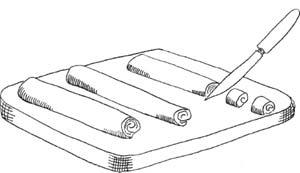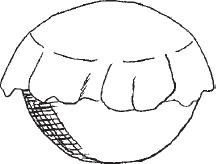Nourishing Traditions: The Cookbook That Challenges Politically Correct Nutrition and The... (135 page)
Authors: Sally Fallon,Pat Connolly,Phd. Mary G. Enig
Tags: #Non-Fiction, #Reference, #Science, #Health
Soak cornmeal in lime water for about 7 hours. Stir in buttermilk, kefir or yoghurt, cover and leave in a warm place for 12 to 24 hours. (Those with milk allergies may use
2 cups water plus 2 tablespoons whey, lemon juice or vinegar
in place of undiluted buttermilk, kefir or yoghurt.) Saute onion in butter. Blend egg yolks into cornmeal mixture along with salt, cayenne pepper, sauteed onions and baking powder. In a clean bowl, beat egg whites with pinch of salt until stiff. Fold into cornmeal mixture and pour into a buttered 9-inch by 13-inch pyrex pan. Bake at least 45 minutes at 375 degrees.

POLENTA
(Italian Corn Casserole)
Serves 8-12
2 cups freshly ground cornmeal
1 cup lime water (see
Whole Grains
)3 cups water or chicken broth (
chicken stock
)2 teaspoons sea salt
1 cup grated Parmesan cheese
1 medium onion, finely chopped, and sauteed in a little butter (optional)
2 tablespoon dried tomato bits, sauteed with the onions (optional)
½ teaspoon dried thyme (optional)
Soak cornmeal in lime water for about 7 hours. Add whey or yoghurt, cover and leave in a warm place at least 12 hours. Bring water or chicken stock and salt to a boil. Slowly add soaked cornmeal, stirring constantly with a whisk. Lower heat and continue stirring for another 15 to 30 minutes until liquid is reduced and polenta is so thick it comes away from the sides of the pan. Stir in cheese and optional ingredients and pour into a buttered 9-inch by 13-inch pyrex dish. Bake at 300 degrees for about 1½ hours.
Variation: Polenta Triangles
Cut
chilled leftover polenta
into triangles and saute in
lard
or a mixture of
butter and extra virgin olive oil.
COUNTRY ITALIAN DINNER
Artichokes
with
Lemon Butter Sauce
Grilled Swordfish
with
Bagnat Sauce
CREAM CHEESE BREAKFAST PASTRIES
(Rugelach)
Makes 18-24
½ cup butter, softened
1 cup homemade
cream cheese
, softened2 cups freshly ground spelt, kamut or whole wheat flour
½ cup Rapadura (see
Guide to Natural Sweeteners
)1 tablespoon vanilla extract
1 teaspoon salt
¼ cup melted butter
2 teaspoons cinnamon
¼ cup
crispy pecans
, finely chopped
Mix butter, cream cheese and flour using an electric beater and leave in a warm place for 12 to 24 hours. Mix in Rapadura, vanilla and salt. Using unbleached white flour to keep from sticking, roll out dough on a pastry cloth to ¼-inch thickness. Brush with mixture of melted butter and cinnamon and sprinkle with pecans. Roll up 1½ turns and cut dough lengthwise. Roll another 1½ turns and cut lengthwise. Repeat once more. You should now have three long rolls. Cut the rolls crosswise into 1-inch or 1½-inch lengths. Place individual pastries on a buttered cookie sheet and bake at 300 degrees for about 45 minutes. These store well in freezer or refrigerator and the flavor improves with time. Reheat before serving.
The fermentation of vegetables (sauerkraut, kimchi, pickles), grains (sourdough bread, kvass, kiesiel, kisra, koji), beans (miso, natto, tempeh) and fish are experiencing renewed interest. The savings in refrigeration cost alone would warrant the return to a safer, saner and more savory taste. As the world's fastest and best quality foods, these are always ready to be consumed, cold or warmed. Ancient standard cookbooks never mentioned fermented fast foods for the simple reason that those cookbooks were written for the rich and famous. Reading these ancient texts, one gets the idea that our ancestors spent a great amount of time preparing those fancy and elaborate meals. The truth is, simple folks toiled in the fields long hours, had to be in good health and had little time for preparing moveable-feast style lunches to be quickly consumed in the furrows. These foods often had to stand all morning long in the heat of harvest without the benefit of refrigeration. . .. Sourdough breads, pickled olives, herrings and anchovies, lacto-fermented vegetables and beans and sometimes yoghurt or cheese were the everyday fare. . .. A properly elaborated sourdough loaf acquires an unsurpassed taste and an aroma that no cracker or porridge can ever match. Sauerkraut achieves a succulent gourmet savor that cole-slaw never reaches. If you taste Normandy country farm butter, churned from aged fermented sour cream, you will never again eat creamery butter. Jacques DeLangre
Seasalt's Hidden Powers

SOURDOUGH STARTER
Makes about 3 quarts
2 cups freshly ground rye flour
2 cups cold filtered water
cheesecloth
6 cups freshly ground rye flour
cold filtered water
Best results for sourdough starter are obtained from rye rather than wheat flour, perhaps because rye contains a lower phytate content than wheat. You will need two gallon-sized bowls. Total time to make the starter is 1 week.
Grind 2 cups flour and let it sit for a bit to cool. In one large bowl, mix flour with 2 cups of cold water. The mixture should be quite soupy. Cover with a double layer of cheesecloth secured with a rubber band—this will allow yeasts and bacteria to get in but will keep insects out. In warm weather, you may set the bowl outside in the shade if you live in an unpolluted area and no pesticides have been used in your garden. Otherwise, keep it in a warm open area indoors or on a patio.
The next day and every day for a total of 7 days, transfer the starter to the other clean bowl and add 1 cup freshly ground rye flour plus enough cold water to make a soupy mixture. Cover and let stand. After a few days the starter will begin to bubble and develop a wine-like aroma. It should go through a bubbly, frothy stage and then subside. After 7 days, the starter is ready for breadmaking. Use 2 quarts for a batch of
sour dough bread
but save 1 quart for your next batch of starter. If not using remaining starter immediately, you may store it in airtight jars in the refrigerator or freezer.Do not be tempted to add honey to your starter, as some recipes require. Honey encourages the proliferation of yeasts at the expense of lactic-acid-producing bacteria and may give you an alcoholic fermentation.
To start a new batch of starter, place the quart of leftover starter in a clean bowl. Add 1 cup freshly ground rye flour plus water each day, changing bowls, until 3 quarts are obtained. Note: See
Sources
for sourdough starters by mail order.
"But how do you make the sourdough?" Mrs. Boast asked.
"You start it," said Ma, "by putting some flour and warm water in a jar and letting it stand till it sours."
"Then when you use it, always leave a little," said Laura, "and put in the scraps of biscuit dough, like this, and more warm water," Laura put in the warm water, "and cover it," she put the clean cloth and the plate on the jar, "and just set it in a warm place," she set it in its place on the shelf by the stove. "And it's always ready to use, whenever you want it." Laura Ingalls Wilder
By the Shores of Silver Lake

The history of bread making is a good example of the industrialization and standardization of a technique that was formerly empiric. . .. It was simpler to replace natural leaven with brewers yeast. There are numerous practical advantages: the fermentation is more regular, more rapid and the bread rises better. But the fermentation becomes mainly an alcoholic fermentation and the acidification is greatly lessened. The bread is less digestible, less tasty and spoils more easily. Claude Aubert
Les Aliments Fermentes Traditionnels
SOURDOUGH BREAD
Makes 3 large loaves or 5-6 smaller loaves
2 quarts sourdough starter
13 cups freshly ground spelt, kamut or hard winter wheat
2 ½ tablespoons coarse sea salt
about 1½ cups cold filtered water
Traditional sourdough bread, prepared with a starter rather than with yeast, has a delicious flavor but tends to be heavy for modern tastes. Spelt gives the most satisfactory loaf.
Your starter should be at room temperature and have gone through the bubbling, frothy stage.
Place starter, salt and 1 cup water in a large bowl and mix with a wooden spoon until the salt crystals have dissolved. Slowly mix in the flour. Towards the end you will find it easier to mix with your hands. You may add the other ½ cup of water if the dough becomes too thick. It should be rather soft and easy to work. Knead by pulling and folding over, right in the bowl, for 10 to 15 minutes; or knead in batches in your food processor.
Without pressing down the dough, cut or shape loaves into the desired shapes or place into 3 large well-buttered loaf pans or 5-6 smaller loaf pans. Cut a few slits in the top of the dough, cover and let rise from 4 to 12 hours, depending on the temperature. Bake at 350 degrees for about an hour. Allow to cool before slicing.
The bread will keep for up to a week without refrigeration.